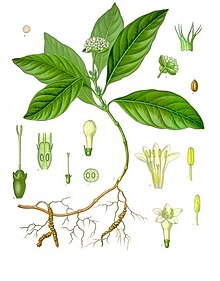Ipecacuanha alkaloids
Ipecacuanha alkaloids are natural products of the isoquinoline alkaloid type.
Occurrence
Ipecacuanha alkaloids are found mainly in the South American emetic root and the Central American Psychotria granadensis . Cephaelin was also discovered in Alangium lamarckii (synonym: Alangium salviifolium ) native to India . The drug Radix Ipecacuanhae is made from Uragoga ipecacuanha .
Representative
The Ipecacuanha alkaloids are characterized by one or two isoquinoline units and one monoterpenoid unit. Representatives are u. a. Emetine , Protoemetin , cephaelin , Ipecosid and Alangisid .
properties
Emetine is very damaging to the heart muscle. It also leads to bloody diarrhea. Resorption causes severe liver damage and paralysis of the spinal cord and brain. It also shows anti-tumor and antibacterial effects. It is a highly toxic oral emetic ; the lethal dose for humans is around 1 g. Cephaelin has a similar effect. The drug Radix Ipecacuanhae is used in the production of homeopathic medicines for vomiting, gastrointestinal diseases and migraines.
history
The final structure was established by Robinson in 1948 on the basis of Woodward 's cleavage of an aromatic ring.
Individual evidence
- ↑ a b c d Entry on Ipecacuanha alkaloids. In: Römpp Online . Georg Thieme Verlag, accessed on May 7, 2020.
- ↑ a b c E. Breitmaier: Alkaloids . Springer Fachmedien, Wiesbaden 1997, ISBN 978-3-519-03542-8 , pp. 61 .
- ↑ C. Xie, J. Luo, Y. Zhang, L. Zhu, R. Hong: A Chiral Pentenolide-Based Unified Strategy toward Dihydrocorynantheal, Dihydrocorynantheol, Protoemetine, Protoemetinol, and Yohimbane . In: Organic Letters . tape 19 , no. 13 , 2017, p. 3594 , doi : 10.1021 / acs.orglett.7b01573 .
- ^ P. Nuhn: Naturstoffchemie . 4th edition. S. Hirzel Verlag, Stuttgart 2006, ISBN 978-3-7776-1363-5 , p. 604 .




